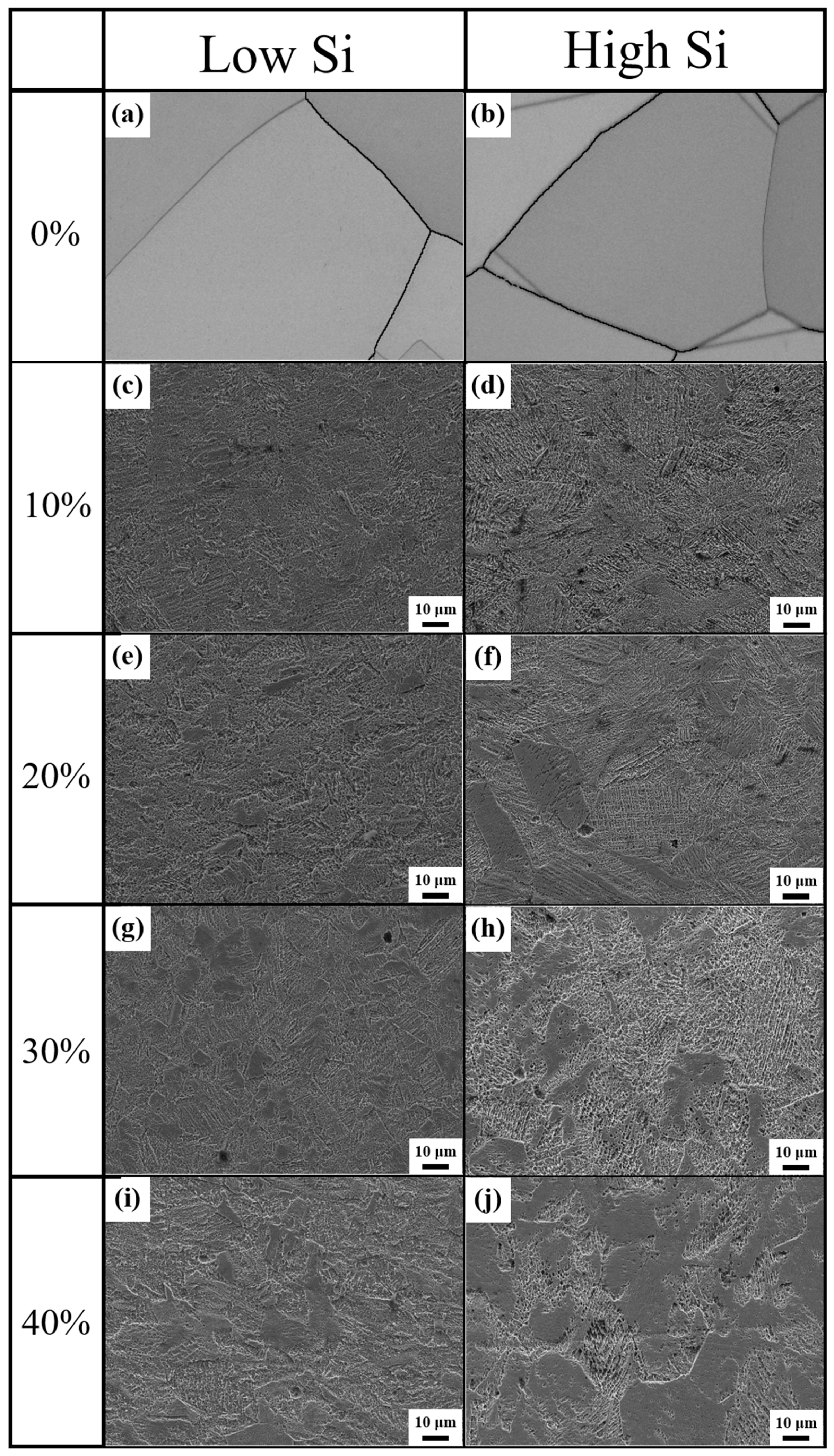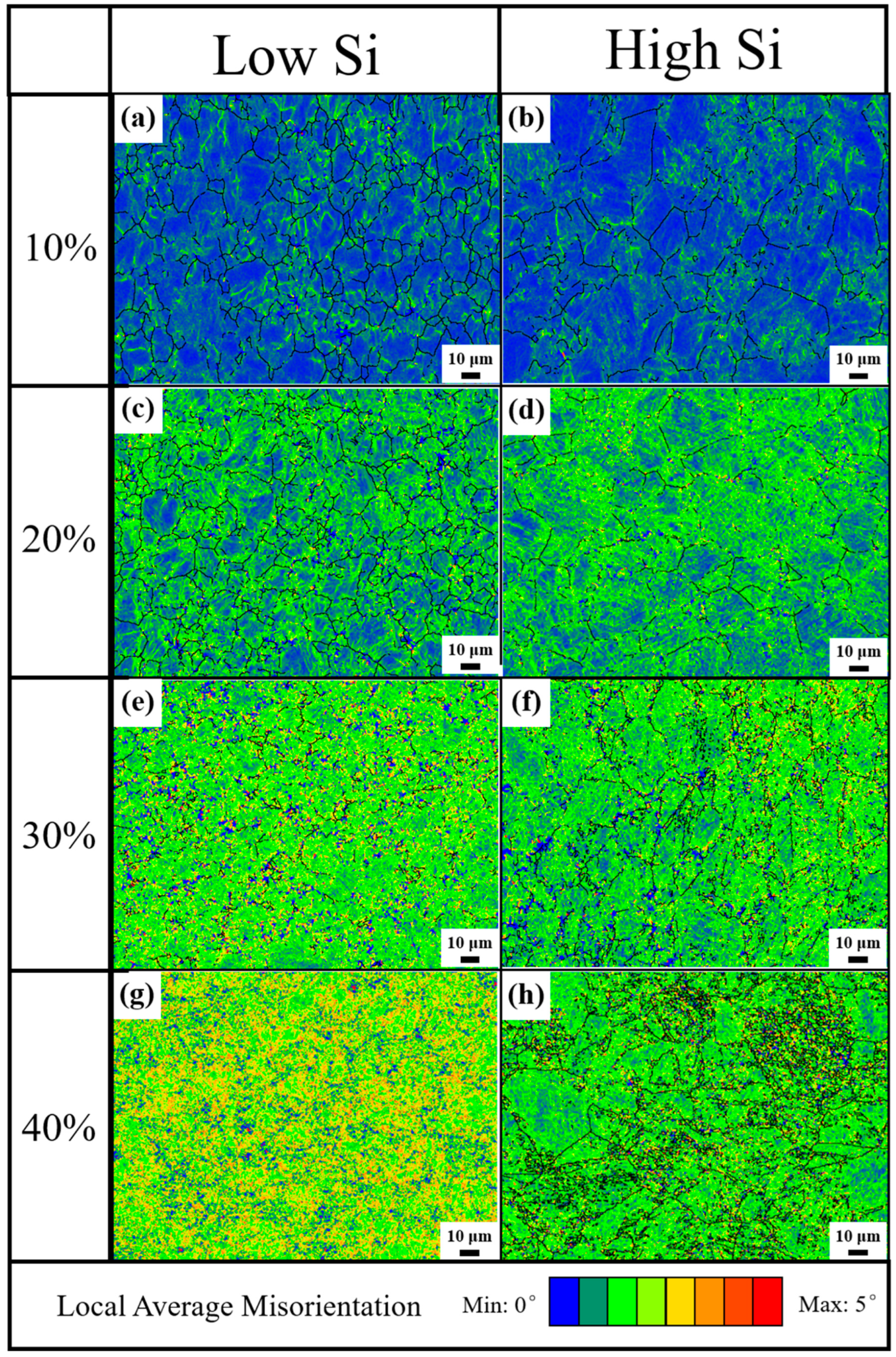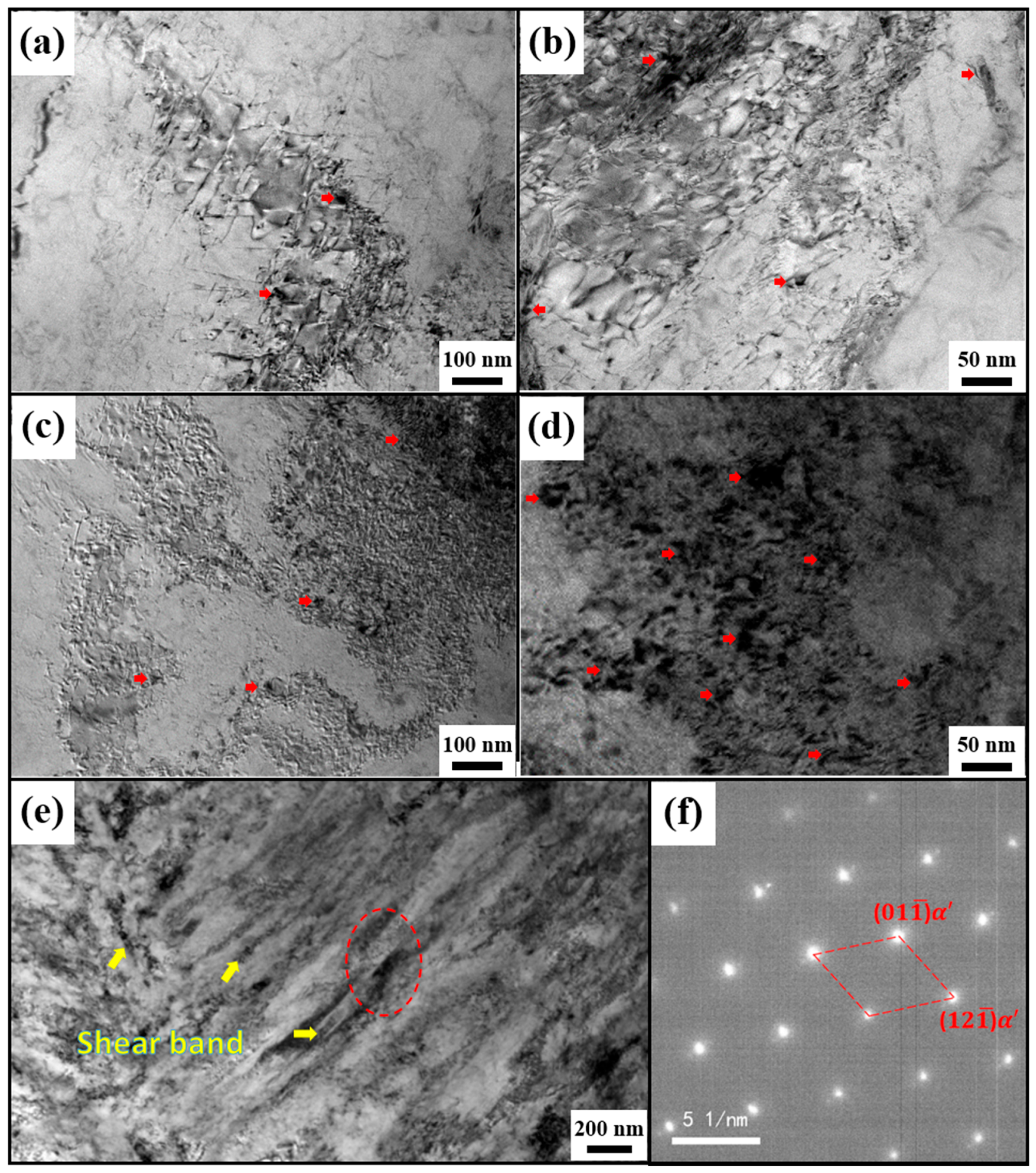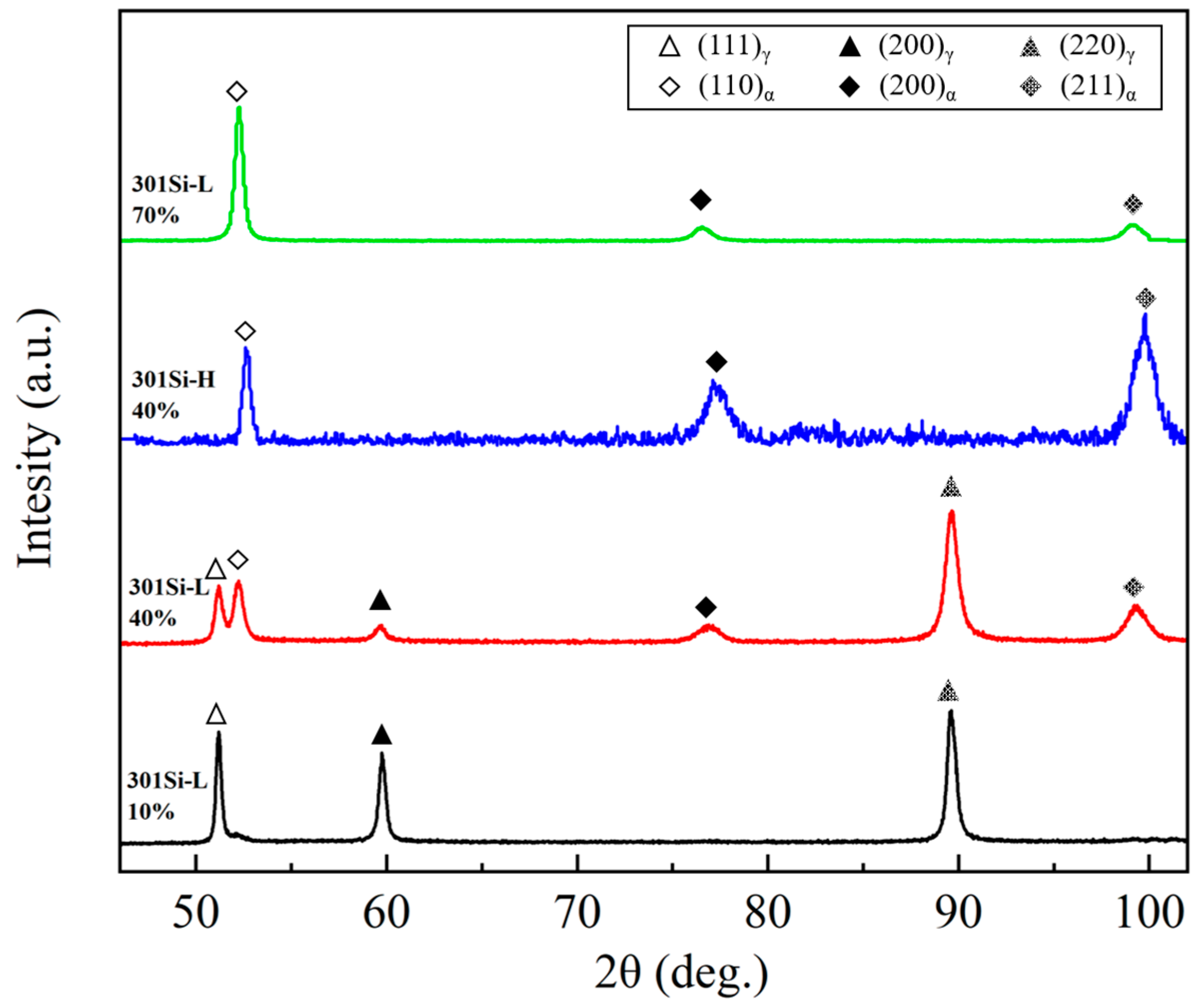Effect of Silicon on the Martensitic Nucleation and Transformation of 301 Stainless Steel under Various Cold-Rolling Deformations
Abstract
1. Introduction
2. Experimental Section
3. Results and Discussion
4. Conclusions
Author Contributions
Funding
Data Availability Statement
Conflicts of Interest
References
- Srivatsan, S.T.; Manigandan, K. Processing, Characteristics and applications of bulk nanostructured metals and alloys. Curr. Nanomater. 2021, 6, 90–105. [Google Scholar] [CrossRef]
- Dehm, G.; Jaya, B.N.; Raghavan, R.; Kirchlechner, C. Overview on micro-and nanomechanical testing: New insights in interface plasticity and fracture at small length scales. Acta Mater. 2018, 142, 248–282. [Google Scholar] [CrossRef]
- Stráská, J. Physical Properties of Ultrafine-Grained Magnesium Based Alloys Prepared by Various Severe Plastic Deformation Techniques. Ph.D. Thesis, Charles University, Prague, Czech Republic, 2014. [Google Scholar]
- Jebelli, A.A.; Fereshteh-Saniee, F. Superior combined strength and elongation by conducting elevated temperature constrained groove pressing on Al–Mg–Mn sheets. Mater. Chem. Phys. 2023, 307, 128090. [Google Scholar] [CrossRef]
- Gupta, R.K.; Birbilis, N. The influence of nanocrystalline structure and processing route on corrosion of stainless steel: A review. Corros. Sci. 2015, 92, 1–15. [Google Scholar] [CrossRef]
- Kowalska, J.; Witkowska, M. The Influence of Cold Deformation and Annealing on Texture Changes in Austenitic Stainless Steel. Adv. Sci. Technol. Res. J. 2024, 18, 143–158. [Google Scholar] [CrossRef] [PubMed]
- Shahri, M.G.; Hosseini, S.R.; Salehi, M. Formation of nano/ultrafine grains in AISI 321 stainless steel using advanced thermo-mechanical process. Acta Metall. Sin. 2015, 28, 499–504. [Google Scholar] [CrossRef]
- Sun, G.S.; Du, L.X.; Hu, J.; Zhang, B.; Misra, R.D.K. On the influence of deformation mechanism during cold and warm rolling on annealing behavior of a 304 stainless steel. Mater. Sci. Eng. A 2019, 746, 341–355. [Google Scholar] [CrossRef]
- Järvenpää, A.; Jaskari, M.; Juuti, T.; Karjalainen, P. Demonstrating the effect of precipitation on the mechanical stability of fine-grained austenite in reversion-treated 301LN stainless steel. Metals 2017, 7, 344. [Google Scholar] [CrossRef]
- Haušild, P.; Davydov, V.; Drahokoupil, J.; Landa, M.; Pilvin, P. Characterization of strain-induced martensitic transformation in a metastable austenitic stainless steel. Mater. Des. 2010, 31, 1821–1827. [Google Scholar] [CrossRef]
- Sohrabi, M.J.; Naghizadeh, M.; Mirzadeh, H. Deformation-induced martensite in austenitic stainless steels: A review. Arch. Civ. Mech. Eng. 2020, 20, 124. [Google Scholar] [CrossRef]
- Izuta, Y.; Prasad, K.; Ito, A.; Tanaka, M.; Torizuka, S. Transmission X ray diffraction characterization of deformation induced martensite in 301 and 304 stainless steels rolled at 77K: Role of grain size. Mater. Sci. Eng. A 2020, 794, 139984. [Google Scholar] [CrossRef]
- Johannsen, D.L.; Kyrolainen, A.; Ferreira, P.J. Influence of annealing treatment on the formation of nano/submicron grain size AISI 301 austenitic stainless steels. Metall. Mater. Trans. A 2006, 37, 2325–2338. [Google Scholar] [CrossRef]
- Misra, R.D.K.; Nayak, S.; Venkatasurya, P.K.C.; Ramuni, V.; Somani, M.C.; Karjalainen, L.P. Nanograined/ultrafine-grained structure and tensile deformation behavior of shear phase reversion-induced 301 austenitic stainless steel. Metall. Mater. Trans. A 2010, 41, 2162–2174. [Google Scholar] [CrossRef]
- Eskandari, M.; Kermanpur, A.; Najafizadeh, A. Formation of nano-grained structure in a 301 stainless steel using a repetitive thermo-mechanical treatment. Mater. Lett. 2009, 63, 1442–1444. [Google Scholar] [CrossRef]
- Wang, Y.; Hu, Y.X.; Mao, F.; Li, J.; Zhou, J.; Zhang, S.H.; Wei, L.L.; Misra, R.D.K.; Liu, B.; Xu, H.; et al. Microstructure evolution and mechanical properties of bimodal grain sized 301 stainless steel strip induced by reverse phase transformation. J. Mater. Res. Technol. 2022, 17, 2772–2781. [Google Scholar] [CrossRef]
- Zhao, L.Y.; Yang, J.W.; Tian, L.; Li, X.L.; Lei, C.S.; Wang, H.F. The Influence of Tempering Parameters on the Microstructure, Mechanical Property, and the Corresponding Strengthening Mechanism of Metastable 301 Austenitic Stainless Steel. Steel Res. Int. 2024, 95, 2300674. [Google Scholar] [CrossRef]
- Lü, Y.P.; Hutchinson, B.; Molodov, D.A.; Gottstein, G. Effect of deformation and annealing on the formation and reversion of ε-martensite in an Fe–Mn–C alloy. Acta Mater. 2010, 58, 3079–3090. [Google Scholar] [CrossRef]
- Sohrabi, M.J.; Mirzadeh, H.; Dehghanian, C. Thermodynamics basis of saturation of martensite content during reversion annealing of cold rolled metastable austenitic steel. Vacuum 2020, 174, 109220. [Google Scholar] [CrossRef]
- Shakhova, I.; Dudko, V.; Belyakov, A.; Tsuzaki, K.; Kaibyshev, R. Effect of large strain cold rolling and subsequent annealing on microstructure and mechanical properties of an austenitic stainless steel. Mater. Sci. Eng. A 2012, 545, 176–186. [Google Scholar] [CrossRef]
- Sotniczuk, A.; Kuczyńska-Zemła, D.; Królikowski, A.; Garbacz, H. Enhancement of the corrosion resistance and mechanical properties of nanocrystalline titanium by low-temperature annealing. Corros. Sci. 2019, 147, 342–349. [Google Scholar] [CrossRef]
- Ahmedabadi, P.M.; Kain, V.; Dangi, B.K.; Samajdar, I. Role of grain boundary nature and residual strain in controlling sensitisation of type 304 stainless steel. Corros. Sci. 2013, 66, 242–255. [Google Scholar] [CrossRef]
- Jones, R.; Randle, V. Sensitisation behaviour of grain boundary engineered austenitic stainless steel. Mater. Sci. Eng. A 2010, 527, 4275–4280. [Google Scholar] [CrossRef]
- Fang, X.Y.; Zhang, K.; Guo, H.; Wang, W.G.; Zhou, B.X. Twin-induced grain boundary engineering in 304 stainless steel. Mater. Sci. Eng. A 2008, 487, 7–13. [Google Scholar] [CrossRef]
- Tsuchida, N.; Ishimaru, E.; Kawa, M. Role of Deformation-Induced Martensite in TRIP Effect of Metastable Austenitic Steels. ISIJ Int. 2021, 61, 556–563. [Google Scholar] [CrossRef]
- Panov, D.; Pertsev, A.; Smirnov, A.; Khotinov, V.; Simonov, Y. Metastable austenitic steel structure and mechanical properties evolution in the process of cold radial forging. Materials 2019, 12, 2058. [Google Scholar] [CrossRef] [PubMed]
- Dastur, P.; Zarei-Hanzaki, A.; Pishbin, M.H.; Moallemi, M.; Abedi, H.R. Transformation and twinning induced plasticity in an advanced high Mn austenitic steel processed by martensite reversion treatment. Mater. Sci. Eng. A 2017, 696, 511–519. [Google Scholar] [CrossRef]
- Naghizadeh, M.; Mirzadeh, H. Microstructural evolutions during annealing of plastically deformed AISI 304 austenitic stainless steel: Martensite reversion, grain refinement, recrystallization, and grain growth. Metall. Mater. Trans. A 2016, 47, 4210–4216. [Google Scholar] [CrossRef]
- Chattopadhyay, S.; Anand, G.; Chowdhury, S.G.; Manna, I. Effect of reverse austenitic transformation on mechanical property and associated texture evolution in AISI 316 austenitic stainless steel processed by low temperature rolling and annealing. Mater. Sci. Eng. A 2018, 734, 139–148. [Google Scholar] [CrossRef]
- Okayasu, M.; Tomida, S. Phase transformation system of austenitic stainless steels obtained by permanent compressive strain. Mater. Sci. Eng. A 2017, 684, 712–725. [Google Scholar] [CrossRef]
- Somani, M.; Karjalainen, L.P.; Kyröläinen, A.; Taulavuori, T. Processing of Submicron Grained Microstructures and Enhanced Mechanical Properties by Cold-Rolling and Reversion Annealing of Metastable Austenitic Stainless Steels. Mater. Sci. Forum 2007, 539–543, 4875–4880. [Google Scholar] [CrossRef]
- Li, D.J.; Feng, Y.R.; Song, S.Y.; Liu, Q.; Bai, Q.; Ren, F.Z.; Shangguan, F.S. Influences of silicon on the work hardening behavior and hot deformation behavior of Fe–25 wt%Mn–(Si, Al) TWIP steel. J. Alloys Compd. 2015, 618, 768–775. [Google Scholar] [CrossRef]
- Takemoto, T.; Murata, Y.; Tanaka, T. Effects of Alloying Elements and Thermomechanical Treatments on Mechanical and Magnetic Properties of Cr-Ni Austenitic Stainless Steel. ISIJ Int. 1990, 30, 608–614. [Google Scholar] [CrossRef]
- Li, Y.J.; Li, J.; Ma, J.Y.; Han, P.D. Influence of Si on strain-induced martensitic transformation in metastable austenitic stainless steel. Mater. Today Commun. 2022, 31, 103577. [Google Scholar] [CrossRef]
- Yang, M.; Lei, L.; You, Y.F.; Wang, P.Z.; Xu, F.H.; Zhao, F.; Liang, Y.L. Enhanced strength-plasticity synergy of 304 stainless steel by introducing gradient nanograined single austenite phase structure via USRP and induction annealing. Mater. Des. 2024, 244, 113123. [Google Scholar] [CrossRef]
- Liu, X.B.; Zhou, M.C.; Zhang, X.F. Ultra-flash annealing constructed heterogeneous austenitic stainless steel with excellent strength-ductility. Mater. Charact. 2022, 192, 112182. [Google Scholar] [CrossRef]
- Liu, J.B.; Chen, C.X.; Feng, Q.; Fang, X.Y.; Wang, H.T.; Liu, F.; Lu, J.; Raabe, D. Dislocation activities at the martensite phase transformation interface in metastable austenitic stainless steel. Mater. Sci. Eng. A 2017, 703, 236–243. [Google Scholar] [CrossRef]
- Lehnhoff, G.R.; Findley, K.O.; De Cooman, B.C. The influence of silicon and aluminum alloying on the lattice parameter and stacking fault energy of austenitic steel. Scr. Mater. 2014, 92, 19–22. [Google Scholar] [CrossRef]
- Jo, Y.H.; Yang, J.; Choi, W.M.; Doh, K.Y.; Lee, D.; Kim, H.S.; Lee, B.J.; Sohn, S.S.; Lee, S. Body-centered-cubic martensite and the role on room-temperature tensile properties in Si-added SiVCrMnFeCo high-entropy alloys. J. Mater. Sci. Technol. 2021, 76, 222–230. [Google Scholar] [CrossRef]
- Lehnhoff, G.R.; Findley, K.O. The Martensitic Transformation and Strain-Hardening Behavior of Austenitic Steels During Fatigue and Tensile Loading. JOM 2014, 66, 756–764. [Google Scholar] [CrossRef]
- Dai, Q.X.; Wang, A.D.; Cheng, X.D.; Luo, X.M. Stacking fault energy of cryogenic austenitic steels. Chin. Phys. 2002, 11, 596–600. [Google Scholar]
- Bracke, L.; Mertens, G.; Penning, J.; De Cooman, B.C.; Liebeherr, M.; Akdut, N. Influence of Phase Transformations on the Mechanical Properties of High-strength Austenitic Fe-Mn-Cr Steel. Metall. Mater. Trans. A 2006, 37, 307–317. [Google Scholar] [CrossRef]
- Choi, J.Y.; Jin, W. Strain Induced Martensite Formation and Its Effect on Strain Hardening Behavior in the Cold Drawn 304 Austenitic Stainless Steel. Scr. Mater. 1997, 36, 99–104. [Google Scholar] [CrossRef]
- Venables, J.A. The Nucleation and Propagation of Deformation Twins. J. Phys. Chem. Solids 1964, 25, 693–700. [Google Scholar] [CrossRef]
- He, Y.S.; Zhou, H.Y.; Liu, W.; Duan, F.M.; Shin, K.; Zhao, Y.C.; Zheng, W.Y. The role of α′-martensite on the variation of compressive residual stress in a gradient nanostructured austenitic stainless steel. Mater. Des. 2024, 238, 112723. [Google Scholar] [CrossRef]
- Shokohfar, A.; Abbasi, S.M.; Yazdani, A.; Rabiee, B. Application of Thermo-Mechanical Process to Achieve Nanostructure in 301 Austenitic Stainless Steels. Defect Diffus. Forum 2011, 312–315, 51–55. [Google Scholar] [CrossRef]
- Li, Z.J.; Chen, L.; Fu, P.X.; Su, H.H.; Dai, P.Q.; Tang, Q.H. The effect of Si addition on the heterogeneous grain structure and mechanical properties of CrCoNi medium entropy alloy. Mater. Sci. Eng. A 2022, 852, 143655. [Google Scholar] [CrossRef]
- Li, Z.J.; Ding, X.K.; Chen, L.; He, J.C.; Chen, J.F.; Chen, J.; Hua, N.B.; Dai, P.Q.; Tang, Q.H. Effect of Si content and annealing temperatures on microstructure, tensile properties of FeCoCrNiMn high entropy alloys. J. Alloys Compd. 2023, 935, 168090. [Google Scholar] [CrossRef]








| Sample | C | Si | Mn | Ni | Cr | Ti | V | Mo | Cu | P | S |
|---|---|---|---|---|---|---|---|---|---|---|---|
| 301Si-L | 0.16 | 0.58 | 1.05 | 7.59 | 16.91 | 0.33 | 0.08 | 0.05 | 0.07 | 0.045 | 0.002 |
| 301Si-H | 0.15 | 1.41 | 1.27 | 7.19 | 17.44 | 0.33 | 0.06 | 0.06 | 0.08 | 0.039 | 0.002 |
| Sample/Phase Content | Austenite | Martensite |
|---|---|---|
| L10 | 86.9% | 13.1% |
| L20 | 81.7% | 18.3% |
| L30 | 57.5% | 42.5% |
| L40 | 50.7% | 49.3% |
| H10 | 73.0% | 27.0% |
| H20 | 65.4% | 34.6% |
| H30 | 36.5% | 63.5% |
| H40 | 9.7% | 90.3% |
| Si | Cr | Ni | Fe | |
|---|---|---|---|---|
| GB | 1.02 | 17.70 | 5.78 | 74.16 |
| near GB | 0.93 | 17.54 | 5.57 | 74.43 |
Disclaimer/Publisher’s Note: The statements, opinions and data contained in all publications are solely those of the individual author(s) and contributor(s) and not of MDPI and/or the editor(s). MDPI and/or the editor(s) disclaim responsibility for any injury to people or property resulting from any ideas, methods, instructions or products referred to in the content. |
© 2024 by the authors. Licensee MDPI, Basel, Switzerland. This article is an open access article distributed under the terms and conditions of the Creative Commons Attribution (CC BY) license (https://creativecommons.org/licenses/by/4.0/).
Share and Cite
Li, J.; Li, Y.; Wang, J.; Han, P. Effect of Silicon on the Martensitic Nucleation and Transformation of 301 Stainless Steel under Various Cold-Rolling Deformations. Metals 2024, 14, 827. https://doi.org/10.3390/met14070827
Li J, Li Y, Wang J, Han P. Effect of Silicon on the Martensitic Nucleation and Transformation of 301 Stainless Steel under Various Cold-Rolling Deformations. Metals. 2024; 14(7):827. https://doi.org/10.3390/met14070827
Chicago/Turabian StyleLi, Jun, Yaji Li, Jian Wang, and Peide Han. 2024. "Effect of Silicon on the Martensitic Nucleation and Transformation of 301 Stainless Steel under Various Cold-Rolling Deformations" Metals 14, no. 7: 827. https://doi.org/10.3390/met14070827
APA StyleLi, J., Li, Y., Wang, J., & Han, P. (2024). Effect of Silicon on the Martensitic Nucleation and Transformation of 301 Stainless Steel under Various Cold-Rolling Deformations. Metals, 14(7), 827. https://doi.org/10.3390/met14070827







